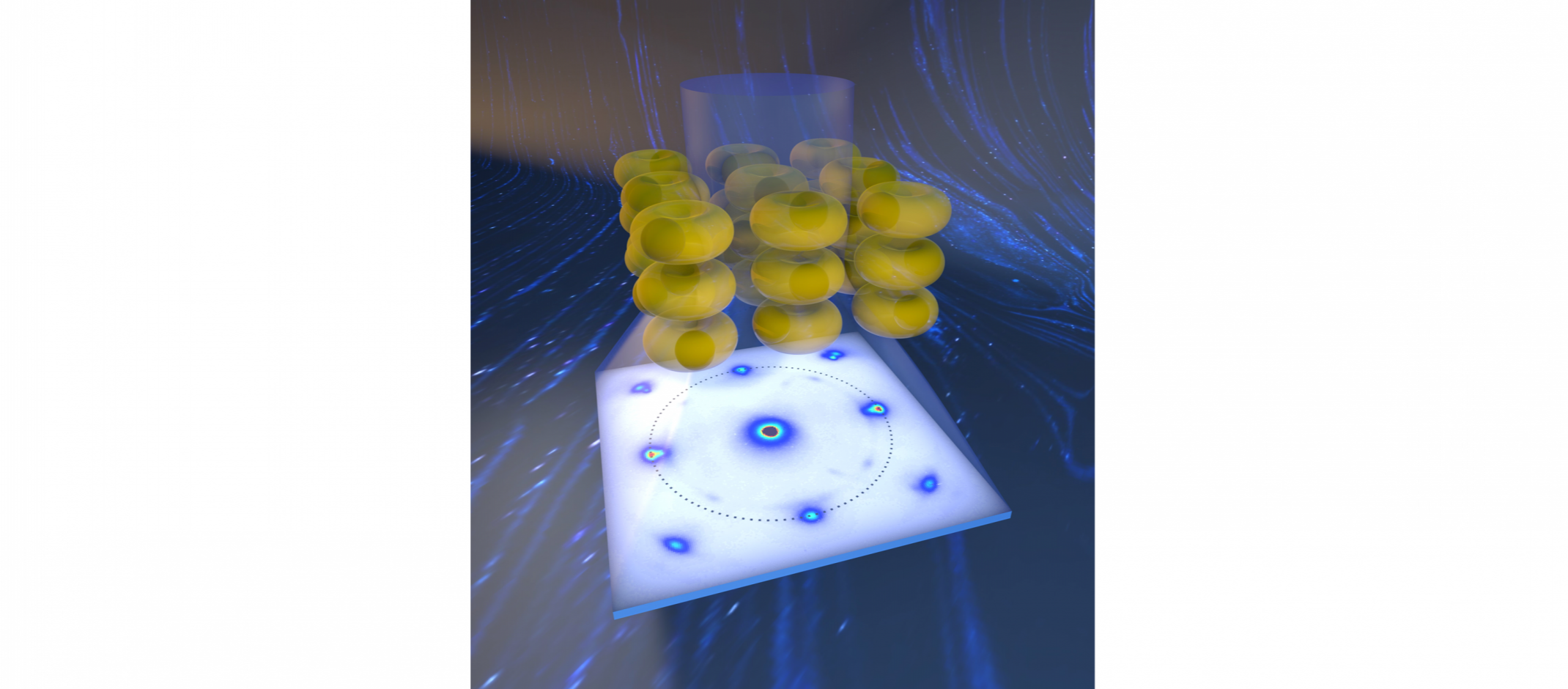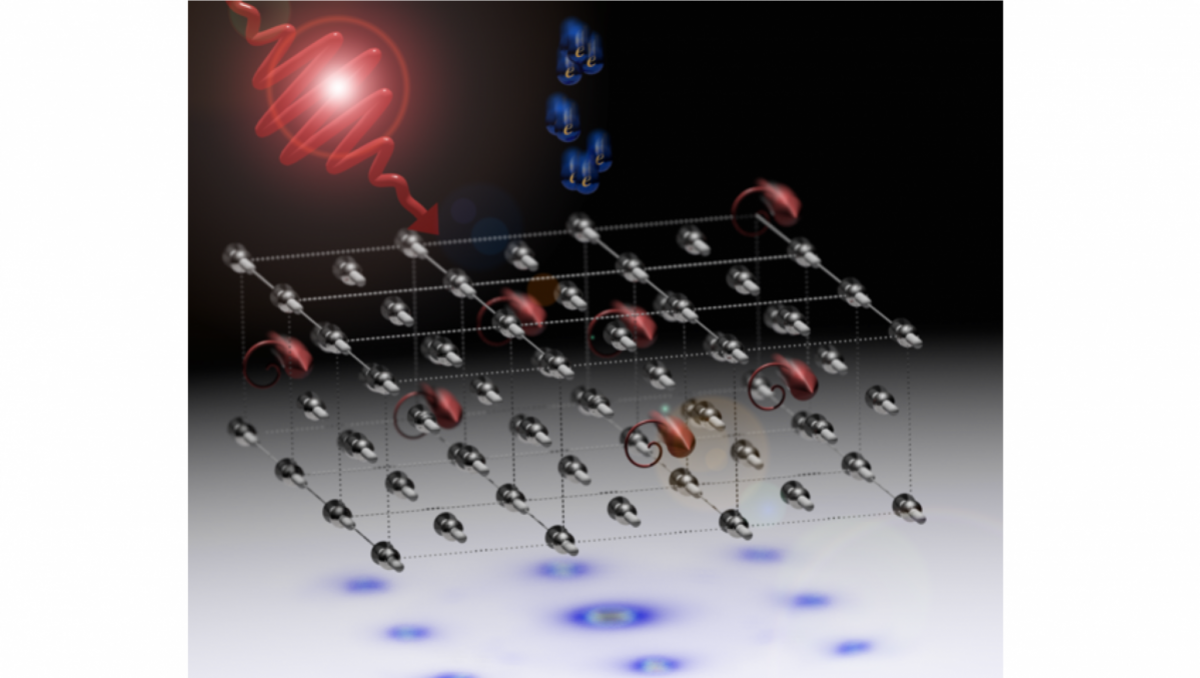The puzzle of the "lost" angular momentum

In a closed physical system, the sum of all angular momentum remains constant – says an important physical law of conservation. Angular momentum does not necessarily need to involve "real" bodily rotation in this context: Magnetic materials even have angular momentum when, seen from outside, they are at rest. Physicists Albert Einstein and Wander Johannes de Haas were able to prove that already in 1915.
If such a magnetized material is now bombarded with short pulses of laser light, it loses its magnetic order extremely quickly. Within femtoseconds – a millionth of a billionth second – it becomes demagnetized. The electrons' angular momentum in the material – also called spin – thus decreases abruptly, much faster than the material can set itself in rotation. According to the conservation principle, however, the angular momentum cannot simply be lost. So, where is the spin angular momentum transferred to in such an extremely short time?
The solution to the puzzle was now published in the scientific journal Nature. In the study, a team led by Konstanz researchers investigated the demagnetization of nickel crystals using ultrafast electron diffraction – a highly precise measuring method in terms of time and space that can make the course of structural changes visible at the atomic level. They were able to show that the electrons of the crystal transfer their angular momentum to the atoms of the crystal lattice within a few hundred femtoseconds during demagnetization. Much like the passengers on a merry-go-round, the atoms are set in motion on tiny circuits and thus balance the angular momentum. It is only much later and more slowly that the macroscopic rotation effect named after Einstein and de Haas begins, which can be measured mechanically. These findings show new ways of controlling angular momentum extremely quickly, opening up new possibilities for improving magnetic information technologies or new research directions in spintronics.

"We hope that this will enable us to produce improved components in the future. Unlike current electronic circuits, these would work with spin transport instead of charge transport, which would be significantly more energy-efficient. By demonstrating that lattice vibrations can transport a spin, we open up a new, potentially promising path towards novel devices in spintronics."
Professor Ulrich Nowak, theoretical physicist at the University of Konstanz
Magnetism in metallic solids
Magnetic phenomena have become an indispensable part of modern technology. They play an important role especially in information processing and data storage. "The speed and efficiency of existing technologies is often limited by the comparatively long duration of magnetic switching processes," explains Professor Peter Baum, experimental physicist at the University of Konstanz and one of the heads of the study. All the more interesting for materials research, therefore, is a surprising phenomenon that can be observed in nickel, among other things: ultrafast demagnetization caused by bombardment with laser pulses.
Just like iron, nickel physically belongs to the ferromagnetic materials. Permanent magnets as we know them from our everyday lives can be made from these materials, for example refrigerator magnets. The permanent magnetization results from a parallel arrangement of the magnetic moments of neighbouring particles of the material. "To illustrate this, we can imagine the magnetic moments as small arrows that all point in the same direction," explains Professor Ulrich Nowak, theoretical physicist at the University of Konstanz and also one of the project leaders. Physically, the angular momentum or spin of the electrons of the ferromagnetic material mainly is the cause for these "arrows" and their direction.
Ultrafast demagnetization via laser
Through bombardment with laser light, the perfect alignment of the magnetic moments can be destroyed within a very short time. "A laser pulse of under 100 femtoseconds is enough to do so. Such laser pulses belong to the shortest human-made events that exist ", explains Ulrich Nowak and continues: "The laser pulse heats the material to such an extent that the 'arrows' – to stay with the image – are swirled around. In the end, one half points one way and the second half points the other way."
This is where the law of conservation of angular momentum comes into play, because the change in direction of the "arrows" changes the spin of the electrons and thus the angular momentum. However, since the sum of all angular momentum in the material must be maintained, the spin cannot simply disappear. Instead, it must be transferred somewhere else in some form. How this can happen within femtoseconds was unclear until now and only contradictory theoretical considerations on this phenomenon existed.
How the puzzle was solved
To solve the physical puzzle, close cooperation between theorists and experimentalists was needed: Based on a hypothesis by the two Konstanz professors Peter Baum and Ulrich Nowak, a team from theoretical physics first used computer simulations to work out a series of predictions about possible atomic movements during ultrafast demagnetization. The experimental physicists then verified these predictions through experiments with femtosecond lasers and ultrashort pulses of electrons. Professor Wolfgang Kreuzpaintner's team at the Technical University of Munich provided the ultrathin nickel crystals.
"For our experiment, we first magnetized our nickel crystal in a specific direction and then demagnetized it with a femtosecond laser pulse in an ultrafast way," says Peter Baum, describing the basic set-up of the experiment. Meanwhile, the researchers led by first author Dr Sonja Tauchert observed the crystal using ultrafast electron diffraction. This method makes it possible to obtain information about the temporal changes in the structure of materials – and to do so with atomic spatial precision and a temporal resolution in the femtosecond range. The resulting sequences of diffraction patterns – atomic slow-motion recordings of demagnetization, so to speak – could then be interpreted using the computer-assisted predictions of the theorists.
"Our experiments and simulations showed that the angular momentum of the electrons is transferred locally to the atoms of the crystal lattice on the same time scale on which the magnetic order of the crystal is lost", explains Ulrich Nowak. At first, a few atoms begin to move in circular orbits around their original resting position. Through interaction with neighbouring atoms, this movement and thus the angular momentum is very quickly transferred to all other atoms. Finally, the entire crystal lattice uniformly oscillates in tiny circular orbits. Physicist generally refer to such a collective lattice vibration as "phonon". In the special case described, these phonons are circularly polarized and therefore carry angular momentum.
Spintronics

"This not only solved an old mystery in solid-state physics, but simultaneously provided experimental proof that polarized lattice vibrations can indeed transport angular momentum – very effectively and in an ultrafast way. The Einstein-de-Haas effect has an intermediate step on atomic dimensions."
Professor Peter Baum, experimental physicist at the University of Konstanz
Such effects might be used to control magnetic materials using laser light and potentially create more efficient alternatives to conventional electronics. "We hope that this will enable us to produce improved components in the future. Unlike current electronic circuits, these would work with spin transport instead of charge transport, which would be significantly more energy-efficient," explains Ulrich Nowak. "By demonstrating that lattice vibrations can transport a spin, we open up a new, potentially promising path towards novel devices in spintronics."
Original publication: S. R. Tauchert, M. Volkov, D. Ehberger, D. Kazenwadel, M. Evers, H. Lange, A. Donges, A. Book, W. Kreuzpaintner, U. Nowak, P. Baum (2022) Polarized phonons carry angular momentum in ultrafast demagnetization. Nature; DOI: 10.1038/s41586-021-04306-4


